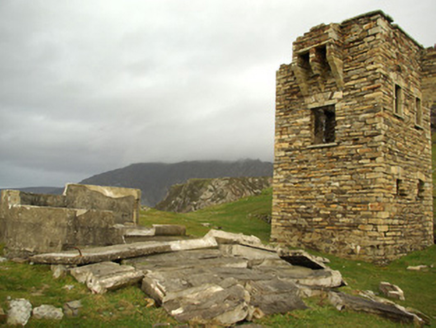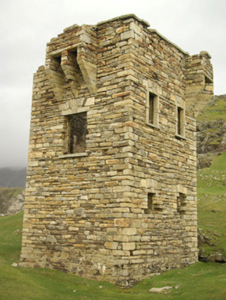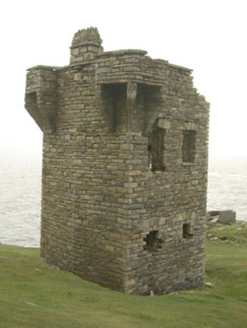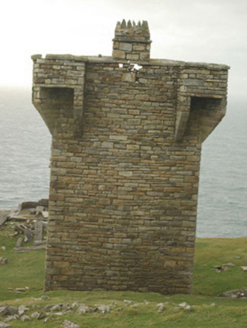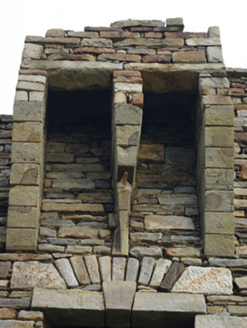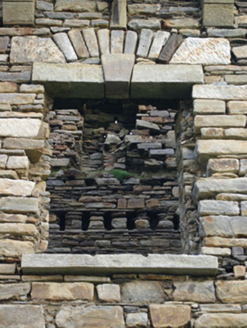Survey Data
Reg No
40909601
Rating
Regional
Categories of Special Interest
Architectural, Historical
Previous Name
Carrigan Head Signal Tower
Original Use
Signal tower
Date
1800 - 1810
Coordinates
156149, 374869
Date Recorded
04/12/2007
Date Updated
--/--/--
Description
Freestanding three-storey former signal tower on square-plan, built c.1805, having machicolations to the corners of the north elevation and with central machicolation to the west elevation at parapet level. Now out of use and derelict. Flat roof, now collapsed, originally hidden behind raised parapet having cut stone coping over. Rubble stone chimneystack to the centre of the north elevation having cut stone stringcourse. Remains of cantilevered stone walkways at parapet level. Constructed of rubble and roughly squared rubble stone masonry with flush roughly-squared quoins to the corners. Slight angled projection to the centre of the north elevation. Ashlar stone supports/corbels to machicolations. Square-headed window and door openings having cut stone sills, and some retaining cut stone block-and-start surrounds with keystone detail over. Rubble stone relieving arches over a number of window openings. Original window fittings now gone. Original doorway not discernable, possibly to the south elevation. Remains of fireplace to the north elevation at ground floor level having recesses to either side; fireplace with cantilevered hearth stone at second floor level over. Located in prominent location at the tip of Ceann an Charraigín [Carrigan Head] and surrounded on three sides by the Atlantic Ocean. Ruinous detached single-bay single-storey former World War Two watchman's station located adjacent to the south (see 40909614).
Appraisal
This notable former Napoleonic-era signal tower occupies a dramatic coastal location on Ceann an Charraigín [Carrigan Head] and is a prominent local landmark in the scenic landscape to the west of Cill Charta [Kilcar]. This structure is one of upwards of eighty such buildings that were constructed along the west, south, south-east and north-west coastlines of Ireland by British authorities between 1804 and 1806 in reaction to the various French invasion attempts in the 1790s, particularly the 1798 French landing at Killala in County Mayo. Signal towers were generally built to the same plan, although some slight regional variations are found. They worked on a signalling system using ball and flag methods, where various messages could be transmitted from station to station, quickly raising the alarm in case of the siting of enemy vessels and fleets etc. A fifty foot mast was positioned on the seaward side of the signal tower where the flags and balls would be hoisted so that the next signal tower could see the message and pass it on to the adjacent one and so forth. In order to cut construction costs etc., signal towers are, as a rule, located on high ground with a clear line of sight over the sea and to the neighbouring towers to either side (in this case with Malin Beg (see 40908901) to the north-east and one at Saint John's Point to the south-east (now demolished)). Therefore, the presence of a signal tower guarantees spectacular views and situations, as is the case here at Ceann an Charraigín [Carrigan Head]. Following the Royal Navy's (under Nelson) victory over the French and Spanish fleets at the Battle of Trafalgar in 1805, the threat of invasion diminished substantially, and by 1809 the decision was made to abandon the signal towers that are dotted along the Irish coastline. These structures now act as tangible historical documents of this era in Irish history and are appealing landmarks of some picturesque value along the Irish coastline. This example at Ceann an Charraigín [Carrigan Head] is notable in that it survives in particularly good condition, and it is one of the few buildings of its type that still retains the high quality cut stone surrounds to the openings (these have been robbed from other sites). The machicolation to the centre of the south elevation was sited to defend the main entrance below, which was accessed via a retractable ladder. This signal tower cost £696 to construct, the most expensive of four towers constructed in south-west Donegal. The construction of this signal station at Ceann an Charraigín [Carrigan Head] and a number of others in Donegal was overseen by Major-General Sir Charles Ross. Works began here in September 1804 and were described as almost finished a year later with the signal mast erected. A signal lieutenant was appointed here in February 1806, indicating that construction works were completed by this time. This structure is a local landmark and represents an integral element of the built heritage and history of the Cill Charta [Kilcar] area.
